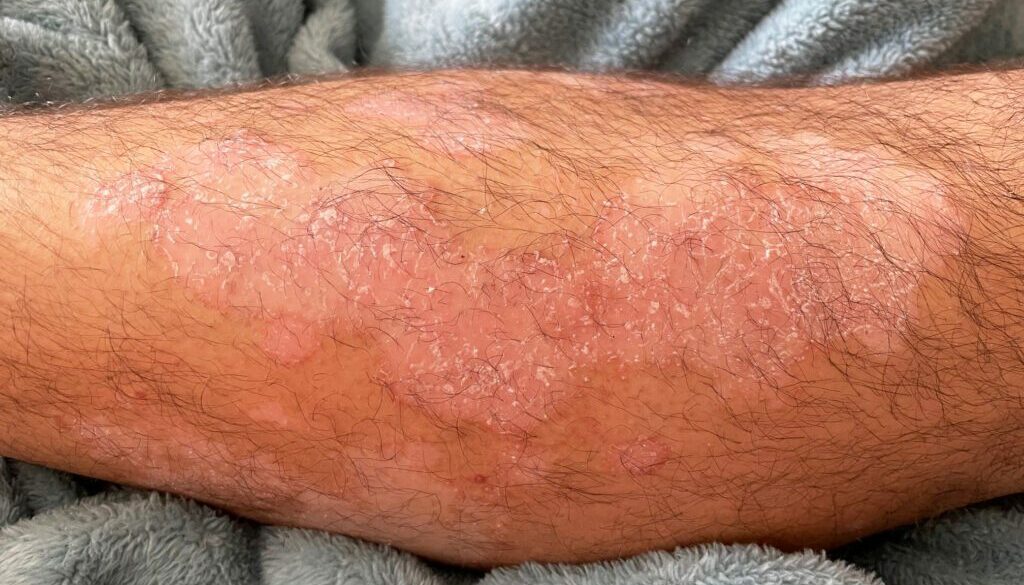Understanding Psoriasis
Psoriasis can be a frustrating skin condition to live with. Kim Kardashian, a popular social media and television personality, has been candid about her struggles with this common condition. In 2018, she explained how it had spread, adding, “It’s taken over my body.” She went on to seek treatment from a dermatologist to gain some control over her skin.
Psoriasis is believed to affect 1 in 50 people, affecting all ages, races, and genders. Currently, it is thought that psoriasis affects roughly 100 million people worldwide, and nearly 7.6 million Americans, making it a global problem.
Bringing awareness to psoriasis can clear up some common misconceptions and provide a better understanding of this chronic condition and what you can do about it. Dr. Fabrizio Galimberti with CMC Dermatology is answering some common questions about psoriasis and how he can help his patients manage the disease.
What is psoriasis?
Psoriasis is a chronic, inflammatory condition, which affects the skin’s surface. The condition causes inflamed, red, flaky, and itchy skin, often around the knees, elbows, and scalp. These symptoms occur because the immune system is sending out faulty signals that speed up the growth cycle of skin cells. This results in the rapid build-up of skin cells on the surface.
“Psoriasis is an interesting condition,” said Dr. Galimberti, “because even though we see it on our skin, it does not start on our skin. It’s caused by inflammation that starts inside our bodies. Inflammation is never good whether it’s on our skin or inside. There are other negative impacts it can have on your health beyond what you see on the surface.”
The exact cause of psoriasis is still not known although we do know there is an abnormal autoimmune response occurring and there are many different factors that can trigger it.
Some contributing factors for psoriasis are:
- Family history
- Injuries, scratches, and bug bites
- Stress
- Smoking
- Heavy alcohol use
- Obesity
- Viral and bacterial infections
- Vitamin D deficiency
What does psoriasis look like?
The appearance of psoriasis is unique to each individual and depends on the type of psoriasis you have. Generally, psoriasis symptoms can range from a few localized spots of dandruff-like, scaly, red patches to vast flare-ups that cover large areas of the body. Most types of psoriasis go through cycles that flare up for a few weeks or months at a time, then subside for a while or even go into complete remission.
Some common signs and symptoms include:
- Red patches of skin covered with thick, silver-colored scales
- Small scaly spots
- Dry, cracked skin that sometimes bleeds
- Itching, burning, or soreness
- Abnormal nail beds including thickened, pitted, or ridged nails
- Swollen and/or stiff joints
Risk factors of psoriasis
Psoriasis can also affect more than just the skin. It can have a wide range of health complications and increase the chances of certain diseases. “As I previously mentioned, the root cause of psoriasis is inflammation inside the body,” explained Dr. Galimberti. “Indeed patients with psoriasis have a 6 times higher chance of having a heart attack than patients without psoriasis. So you see psoriasis on your skin, but you want to treat it not just because of the way it looks and feels, but for your overall health.”
Dr. Galimberti pointed out that psoriasis is known to increase your chances of heart attacks as well as high blood pressure, obesity, and type 2 diabetes. It can exacerbate other existing health issues like autoimmune diseases and other inflammatory conditions like Crohn’s disease. People suffering from psoriasis are also prone to mental health issues and depression associated with low self-esteem.
If untreated, one of the most serious complications that can develop is psoriatic arthritis. Up to 30 percent of people with psoriasis develop psoriatic arthritis, which can cause joint damage and lead to severe pain, swelling, and loss of mobility. Without treatment, it can be very disabling.
Who should you see for your psoriasis treatment?
While this can all sound overwhelming, there are many effective ways to treat psoriasis. At CMC Dermatology, Dr. Galimberti is motivated to look beyond the skin when approaching treatment for his patients.
“One way that I like to think of psoriasis is that we see psoriasis on the surface but we don’t see the damage that it’s causing internally. So as a dermatologist not only is the goal for me to help your skin and get rid of the psoriasis plaque, the itching, the flaking, the redness, but to also, at the same time, help your heart, help your joints, and make sure that you don’t get damage from the internal inflammation.”
At CMC Dermatology, Dr. Galimberti utilizes a variety of advanced treatment options that can get his patients clear or nearly clear of psoriasis. Although there is no cure, psoriasis treatments have come a long way. Not only do they target the inflammation caused by the overactive immune system but also improve the internal symptoms.
To learn more about the advanced treatment options for psoriasis and other skin conditions that CMC Dermatology offers or to request an appointment, please call 843-234-8700.
Fabrizio Galimberti, MD
Board Certified in Dermatology and Micrographic Dermatologic Surgery by the American Board of Dermatology





